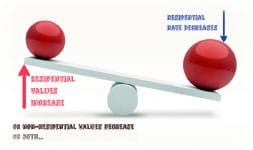Understanding the residential assessment rate

In early May, residents will receive their Notice of Value for 2017, which will reflect the market value of a residence as of June 30, 2016. This year, while home values have increased, residents will not notice an equivalent change in their property taxes due next year.
By Lynne Marsala Basche
In early May, Douglas County residents will receive their Notice of Value for 2017. The notice will reflect the market value of a residence as of June 30, 2016. This year, while home values in the Denver Metro area have increased, residents will not notice an equivalent change in their property taxes due next year because an important component of the tax calculation is expected to decrease. Residential property is assessed differently from all other property types, and knowing how the residential assessment rate is calculated, as well as where tax dollars are allocated, is just as important as writing the check.
An “assessment rate” is the percentage of a property’s value that is subject to taxation. Residents are not taxed on the entire value of their home; rather, only a portion. The assessment rate is determined by the legislature every two years and changes based on residential and nonresidential (i.e. business, farms, oil and gas property, vacant land) property valuation to maintain a tax balance.
In 1982, Colorado voters approved The Gallagher Amendment, which, in part, stated that the amount of residential property taxes collected statewide always had to be lower than the amount of property taxes collected on nonresidential properties. The amendment dictated that of the statewide total, taxes on residential property must be 45 percent, and taxes on nonresidential property made up the remaining 55 percent. Gallagher also fixed the assessment rate on nonresidential property at 29 percent and noted the rate on residential property had to shift to maintain the 45/55 ratio.
The assessment rate should have increased to 9.13 percent in 2013 to maintain the 45/55 split, but it did not happen because of the Taxpayers Bill of Rights (TABOR), which voters passed in 1992. TABOR requires voter approval before all tax increases. The assessment rate can go down to maintain the Gallagher split, but it cannot go back up because of TABOR. The collision between Gallagher and TABOR has forced the residential assessment rate to stay flat or decrease for the past 25 years.
In 2017, residential property value is again growing faster than nonresidential property, and to maintain the Gallagher split, the rate is predicted to drop to the 6.56 percent residents will see on their 2017 Notice of Value.
Why is paying less property tax not necessarily a good thing beyond writing a smaller check? The amount of taxes paid (or not) directly impacts the delivery of services. There is less money to allocate to the cities, county, schools, metro districts and libraries, for example. The ability to accommodate for growth is challenging when there is less revenue per resident.
Visit the Douglas County Assessor’s web site (www.douglas.co.us/assessor/) for a comprehensive overview of your property. Do a property search to learn which tax authorities provide services to your property and receive your tax dollars and become informed and engaged by participating in budget meetings for local taxing authorities. One benefit of local government is that residents have input into their community and hold elected officials accountable. If residents see or feel that the quality of services is diminishing or that issues are not getting addressed as quickly as possible due to budgetary constraints, they can directly affect the results. The key is being aware and getting involved.
If residents have questions about the Notice of Value for 2017 or want to appeal their property value, visit www.douglas.co.us/assessor for information and options.